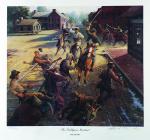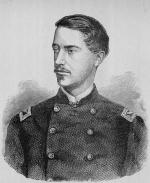![header=[Marker Text] body=[Commanded a detachment of Union cavalry that made a surprise attack on a larger force of Confederate cavalry on this square, July 2, 1863. Important papers for General Lee were taken from the men who were captured.] sign](http://explorepahistory.com/kora/files/1/10/1-A-1ED-139-ExplorePAHistory-a0h2p1-a_450.jpg)
Mouse over for marker text
Name:
Captain Ulric Dahlgren
Region:
Hershey/Gettysburg/Dutch Country Region
County:
Franklin
Marker Location:
Southeast section of square, Greencastle
Dedication Date:
June 21, 1954
Behind the Marker
One of the talented young officers on  Union General George G. Meade's staff was twenty-one-year-old Ulric Dahlgren, son of Rear Admiral John Dahlgren and a friend of Abraham Lincoln. Secretary of War Edwin M. Stanton had personally appointed him to the rank of captain. Born in Neshaminy, Pennsylvania, in April 1842, Dahlgren had served on the staffs of Generals Franz Sigel, Ambrose E. Burnside, and Joseph Hooker, before Meade took command of the Army of the Potomac on June 28th, 1863. A born adventurer, Dahlgren had already shown promise as a daring reconnaissance officer during the Chancellorsville Campaign in May, so when he proposed to General Meade that he scout behind Rebel lines in the Cumberland Valley, the general gave his permission.
Union General George G. Meade's staff was twenty-one-year-old Ulric Dahlgren, son of Rear Admiral John Dahlgren and a friend of Abraham Lincoln. Secretary of War Edwin M. Stanton had personally appointed him to the rank of captain. Born in Neshaminy, Pennsylvania, in April 1842, Dahlgren had served on the staffs of Generals Franz Sigel, Ambrose E. Burnside, and Joseph Hooker, before Meade took command of the Army of the Potomac on June 28th, 1863. A born adventurer, Dahlgren had already shown promise as a daring reconnaissance officer during the Chancellorsville Campaign in May, so when he proposed to General Meade that he scout behind Rebel lines in the Cumberland Valley, the general gave his permission.
Dahlgren selected ten men from Wesley Merritt's cavalry brigade and started out from Frederick, Maryland, on July 1. He and his men all wore civilian clothes so they would not attract attention. Near Hagerstown, Dahlgren met two former Union soldiers who had been discharged in May, who told him that the Confederate army was farther north. The two Yankees agreed to accompany Dahlgren's small party and led the group to a minister's home for supper. Some time after dark, Dahlgren's party finally camped in the woods a few miles outside Greencastle.
At daylight on July 2, one of the Union soldiers, James Moorehead, who was from Greencastle, rode into his home town to ascertain the whereabouts of enemy soldiers. None were around, townspeople informed him. They had all gone north and only a few squads occasionally passed by. Encouraged by this news, Dahlgren's men changed into their uniforms and rode into Greencastle, where they were mobbed by joyous townsfolk who had not seen Yankee soldiers since June 15.
Moorehead then rode out of town to watch for enemy soldiers, but quickly returned with word that a band of the Rebels coming up from the south would soon reach the town. The news cleared the streets of civilians. From the bell tower of the Reformed Church on East Baltimore Street, Dahlgren saw a group of Rebels approaching and decided to confront them.
Dahlgren placed his men near this historical marker and waited. As the enemy detachment of twenty-two infantrymen and two couriers entered the square, Dahlgren commanded his men to left half wheel and charge. The affair was over quickly. Only a few Southerners at the rear of their detachment managed to fire and nobody got hurt. All were taken prisoner. Dahlgren's men then cut open the Confederate mail bags and explored their contents. When one of the couriers objected to being searched, Dahlgren combed through the man's belongings and found a dispatch from President Jefferson Davis to General Robert E. Lee secreted inside a folded shirt and packed inside a valise.
The dispatch was in General Meade's hands late that day. In it, Davis told Lee that the South would be unable to form the new Confederate army in northern Virginia that Lee hoped would threaten Washington and tie down Federal troops. Lee could expect no reinforcements. Meade thus knew that his enemy would not receive any additional soldiers while fighting at Gettysburg. After the war, Meade's detractors exaggerated the importance of Dahlgren's captured letter, arguing that Meade was about to retreat from Gettysburg when the dispatch convinced him to stay and fight. Nothing was further from the truth. Meade had made the decision to fight at Gettysburg on July 1; Dahlgren's capture only reaffirmed his decision.
Dahlgren led a larger detachment that seized more Confederate mail in the Greencastle area, on July 3rd. Later, his men attacked portions of the large Confederate wagon train that retreated from Gettysburg. On July 6, while fighting alongside Judson Kilpatrick's division in the streets of Hagerstown, Dahlgren was seriously wounded, resulting in the amputation of one of his legs.
Promoted to colonel, Dahlgren volunteered to take part in Kilpatrick's February 1864 raid on Richmond. When his column got lost and ambushed, the young colonel was killed. On his body were found documents (perhaps forged according to some accounts) that implicated the colonel in a plot to assassinate Jefferson Davis. His body, partially mutilated by Confederates, was spirited away to Richmond by Union sympathizers and secretly buried. After the war Dahlgren's remains were exhumed and reburied in the Dahlgren family plot located in Philadelphia's Laurel Hill Cemetery.
Dahlgren selected ten men from Wesley Merritt's cavalry brigade and started out from Frederick, Maryland, on July 1. He and his men all wore civilian clothes so they would not attract attention. Near Hagerstown, Dahlgren met two former Union soldiers who had been discharged in May, who told him that the Confederate army was farther north. The two Yankees agreed to accompany Dahlgren's small party and led the group to a minister's home for supper. Some time after dark, Dahlgren's party finally camped in the woods a few miles outside Greencastle.
At daylight on July 2, one of the Union soldiers, James Moorehead, who was from Greencastle, rode into his home town to ascertain the whereabouts of enemy soldiers. None were around, townspeople informed him. They had all gone north and only a few squads occasionally passed by. Encouraged by this news, Dahlgren's men changed into their uniforms and rode into Greencastle, where they were mobbed by joyous townsfolk who had not seen Yankee soldiers since June 15.
Moorehead then rode out of town to watch for enemy soldiers, but quickly returned with word that a band of the Rebels coming up from the south would soon reach the town. The news cleared the streets of civilians. From the bell tower of the Reformed Church on East Baltimore Street, Dahlgren saw a group of Rebels approaching and decided to confront them.
Dahlgren placed his men near this historical marker and waited. As the enemy detachment of twenty-two infantrymen and two couriers entered the square, Dahlgren commanded his men to left half wheel and charge. The affair was over quickly. Only a few Southerners at the rear of their detachment managed to fire and nobody got hurt. All were taken prisoner. Dahlgren's men then cut open the Confederate mail bags and explored their contents. When one of the couriers objected to being searched, Dahlgren combed through the man's belongings and found a dispatch from President Jefferson Davis to General Robert E. Lee secreted inside a folded shirt and packed inside a valise.
The dispatch was in General Meade's hands late that day. In it, Davis told Lee that the South would be unable to form the new Confederate army in northern Virginia that Lee hoped would threaten Washington and tie down Federal troops. Lee could expect no reinforcements. Meade thus knew that his enemy would not receive any additional soldiers while fighting at Gettysburg. After the war, Meade's detractors exaggerated the importance of Dahlgren's captured letter, arguing that Meade was about to retreat from Gettysburg when the dispatch convinced him to stay and fight. Nothing was further from the truth. Meade had made the decision to fight at Gettysburg on July 1; Dahlgren's capture only reaffirmed his decision.
Dahlgren led a larger detachment that seized more Confederate mail in the Greencastle area, on July 3rd. Later, his men attacked portions of the large Confederate wagon train that retreated from Gettysburg. On July 6, while fighting alongside Judson Kilpatrick's division in the streets of Hagerstown, Dahlgren was seriously wounded, resulting in the amputation of one of his legs.
Promoted to colonel, Dahlgren volunteered to take part in Kilpatrick's February 1864 raid on Richmond. When his column got lost and ambushed, the young colonel was killed. On his body were found documents (perhaps forged according to some accounts) that implicated the colonel in a plot to assassinate Jefferson Davis. His body, partially mutilated by Confederates, was spirited away to Richmond by Union sympathizers and secretly buried. After the war Dahlgren's remains were exhumed and reburied in the Dahlgren family plot located in Philadelphia's Laurel Hill Cemetery.






